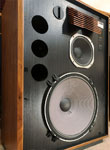
Originally Posted by
Ducatista47

From another thread:
Ah, Coherence, the magic word. He said the magic word! I admit that using crossovers and specialized drivers for each frequency band is an interesting experiment. Obviously one that has taken hold, enabled by the advent of high power (as were so many other audio developments that have proved to be a mixed blessing). Coherency does not come naturally to a multi way system and any success it has there is relative.
But once upon a time, a time I lived through and heard, Full Range drivers were as common as any other type. They were not particularly small, either. In my childhood home they ran from ten to twelve to fifteen inches.
They were naturally and actually (not sort of) coherent, automatically time aligned and perfectly in phase. As an approach it has much to recommend it. These virtues plus the absence of crossovers offered an experience stunning in its own right. Those not old enough to remember good sized Full Range drivers, very efficient by nature, being driven in turn by sweet tube amps of modest wattage, have no idea. Tiny Lowthers and Fostexs are not dynamic enough to even remind one of the systems of the past. Full Range drivers have a small xmax, but the cone size can make up for it.
Since I use both, I can safely say that each approach has something to recommend it and the multiway world is different but not superior. In fact, for listening to the music I like to hear, the Full Range world is markedly superior.
If you think wimpy when you think full range, remember that the classic systems competed directly with horn systems, not AR3's.
The once adventuresome audio scene has been dominated for many, many years by a single pole of the world of possibilities. Multi way speakers with crossovers that render the golden midrange, for better or worse, in hunks. I think what really matters about this is, for everything to be gained by the approach, something else is lost.
I find that for the gain in accuracy, which when comparing good systems to good systems is minor, the lack of signal, phase, location, and time coherency that results is not a minor affair.
Why does all this strike me as odd? Because despite all the back and forth on this site about doing things this way or that way, they are all variations on one of several possible themes. Seen that way, a tempest in a teapot comes to mind. It is like trying out different regional ways of speaking French instead of trying French, German, English and Japanese to find which best expresses what we are trying to communicate.
But, you might say, this is Lansing Heritage. Well, in the Heritage days Mr. Lansing was quite taken with extended range drivers. I know, when Jim Lansing was making extended range drivers the audio world lacked the top octave and the subwoofer range. But now we have tweeters to die for and real subwoofers, and why can't they be married to Full Range drivers as well as to two or three way 40 to 9000hz systems? Well, they can and that is what I listen to most of the time. Because it does a great job if done right, just like the multi way approach does. And it sounds so coherent and natural as compared to the competing approach. My three way of choice is Sub, Full Range and coincident tweeter. Heck, use a 2245H and it will be perfectly on topic.
In my experience at home, I would say multi way is superior for playing really loud and for playing really loud music, like heavy metal, dance club stuff, very hard distorted rock, and large symphony orchestras at full honk. Full range is superior for Jazz, Blues, acoustic, vocal, ambient, electronic, Rock like The Rolling Stones, Jethro Tull, Jeff Beck, Robin Trower. Concrete Blonde, multi way. The Pretenders (classic or contemporary), Full Range. Sorry the examples are ancient history like I am, but you get the picture.
Clark





 Reply With Quote
Reply With Quote










 ) From the rebuttals I read here whenever I mention this stuff, I have to think that hardly anyone here has ever heard this done right. No surprise, since it hardly ever is done right. (Paragraph edited to reflect comments.)
) From the rebuttals I read here whenever I mention this stuff, I have to think that hardly anyone here has ever heard this done right. No surprise, since it hardly ever is done right. (Paragraph edited to reflect comments.) What a great turn of phrase.
What a great turn of phrase.